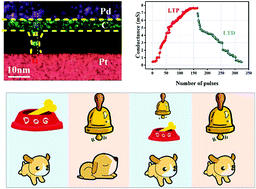A carbon-based memristor design for associative learning activities and neuromorphic computing†
Abstract
Carbon quantum dots (QDs) have attracted significant interest due to their excellent electronic properties and wide application prospects. However, the application of carbon QDs has been rarely reported in memristors. Here, a memristor model with carbon conductive filaments (CFs) is proposed for the first time based on carbon quantum dots. The CF-based devices exhibited excellent resistive switching performance, in particular a narrow range of SET and RESET voltages and good power efficiency and retention properties. These devices could also emulate important biological synapse performances, such as the transition from short-term plasticity (STP) to long-term potentiation (LTP) behaviors, long-term depression (LTD) behavior, and four types of spike-timing-dependent plasticity (STDP) learning rules. Interestingly, Pavlovian associative learning functions were also reliably demonstrated in the memristor device (MD). The digit recognition ability of the MDs was evaluated though a single-layer perceptron model, in which the recognition accuracy of digits reached 92.63% after 250 training iterations. The transmission electron microscopy (TEM) results evidenced that the carbon CF was found in the MD at the “ON” state. Thus, this new carbon CF-based mechanism for memristors provides a new idea for achieving better neuromorphic MDs and applications.



 Please wait while we load your content...
Please wait while we load your content...